The Untold Story of the Battle for Kyiv
By Thayer President, Dan Rice, MBA, MS, MSeD, Thursday, June 02, 2022
*Originally published in Small Wars Journal on May 31, 2022*
The world expected the Russian Army to defeat the Ukrainian Army within days. Russian President Vladimir Putin, United States Senate expert testimony[1], and most of the west, all expected Kyiv to fall within a few days under the weight of the enormous and powerful Russian army. The Russians thought it was going to be quick, but the Russians forgot that the enemy has a vote. The Ukrainian army didn’t collapse. After nearly 100 days, the Ukrainian military continues to surprise the world. Ukrainian President Volodymyr Zalensky inspired the world and displayed his resolve, and his nation’s resolve, to fight the much larger Russian Army.
Instead of collapsing in the face of a Russian invasion along multiple avenues of approach – the drive to Kyiv being a primary one – the Ukrainian Army traded space for time by fighting a withdrawing action against a far larger invading Russian army and fell all the way back to within the city limits of the national capital where it eventually repelled the Russian onslaught[2]. Had Putin’s army taken Kyiv, President Zelensky’s government could have collapsed, and the Ukraine may have lost the war. On the contrary, however, the Ukrainian soldiers and civilians successfully defended its capital in a battle that may likely be taught as a case study for military leaders for generations once it is fully understood.
Being able to tell this story from my vantage point was a story unto itself. At the time there were no US military or embassy in country, and I was traveling as a civilian. After a seven-hour public bus ride from Krakow, Poland into Lviv, Ukraine, I linked up with my contacts for the first time, the Ukraine Chief of Strategic Communications Ms. Liudmyla Dolhonovaka and Colonel Oleksii Noskov from Ukraine Psychological Operations[3]. Together, with my new friends, we drove by car another seven-hour car drive to Kyiv, a total distance from Krakow of 900 kilometers (550 miles) and was finally in the warzone. The drive in was beautiful, driving past enormous farms of beautiful yellow wheat fields from which the yellow and blue sky of the Ukraine flag are derived.
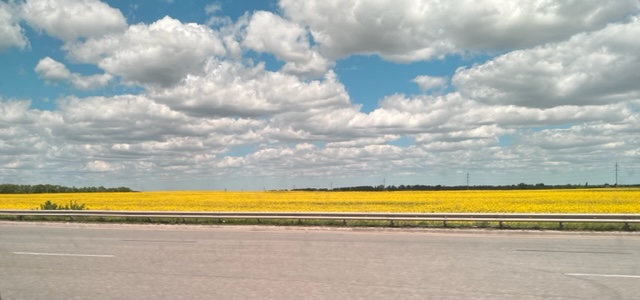
The yellow fields of wheat in Ukraine against the blue sky
On the route in, about 50 kilometers (30 miles) west of Kyiv, we began to see battle damage. Burnt out bombed buildings, destroyed gas stations, 100% disabled Russian tanks facing eastward, and a destroyed Ukrainian highway bridge that had been dropped by the Ukrainians themselves to prevent the Russians from crossing a critical river crossing were just a few of the obstacles I encountered. Ultimately, the Russians never passed that point.
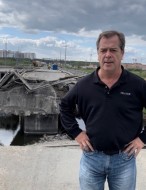
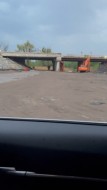
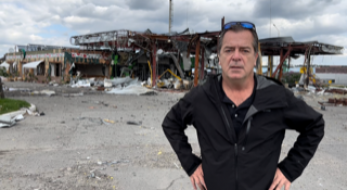
Two bridges in the west and northeast of Kyiv that were intentionally dropped by Ukrainian forces as Russians approached Kyiv and a fuel station near Moschun that was destroyed by Russian forces.
In order to better tell this story, I interviewed many of the commanders who were at decisive points in the Ukrainian War to date for my primary research, especially the battle for Kyiv, and I walked that battlefield with them in May 2022. I was originally in Ukraine to write about leadership, upon the invitation of Commander in Chief, General Valeriy Zaluzhnny. But after a two-hour discussion with him about the Battle for Kyiv - a battle that was eight years in the making - I felt the real story was in a first-hand perspective of the Battle of Kyiv[4]. A story that would provide valuable lessons for military leaders in the future. Few westerners had been in Ukraine during the battle and the Commander had not granted any interviews.
At the end of our meeting, the Commander ran into his office, grabbed an original portrait off the wall of a soldier on Snake Island “communicating with his middle finger” with the Russian flagship Moskva (which later was sunk by two Ukrainian-made Neptune missiles). General Zaluzhnny signed the back of the portrait for me and gifted it to me.

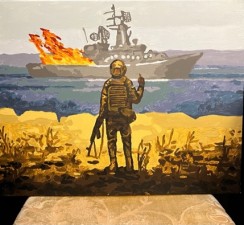
General Zaluzhnny gifting Dan Rice an original portrait of a Ukrainian soldier giving the Moskva the “finger”. Fire was later added to the original after Ukraine sunk the Russian flagship.
At its core, the defense of Kyiv was a turning point in this war that may well go down in the annals of military history as one of the greatest defenses against an overwhelming enemy invoking the likes of David versus Goliath; King Leonidas’s 300 Spartans facing the Persian hordes of Xerxes; or a small British outpost defending against the Zulu’s at Rorke’s Drift. The battle is still fresh in the mind of the leaders and soldiers of the Ukrainian Armed Forces, and certainly the Commander-in-Chief thought documenting it was important enough for commanders to be pulled away from the front lines to meet with me.
The Ukrainians have been in continual combat since 24 Feb 2022. They were on heightened alert 48 hours prior to the war since they anticipated the invasion and with Russian knowledge of disposition of much of the Ukrainian Armed Forces. On 21 Feb 2022, General Zaluzhnny sent a message to the Russians on all Ukrainian websites and social media, in fluent Russian. “You will attack us in 10:1 and 15:1 ratios. We will not meet you with flowers. We will meet you with guns. Welcome to HELL!” Not exactly what the Russians were likely expecting. The message was sent out to all Ukrainian forces and helped rally them.
On all avenues of the planned attack the Ukrainians had spray painted overpasses and signs with “Welcome to hell![5]” A very effective psychological operations (PSYOPS) tactic against the Russian that would wear down the morale of the Russian forces as the Russians took horrible losses and were told to continue to attack. On 22 Feb 2022, under cover of darkness, the Ukrainians started to reposition their forces so that by the time the Russians invaded two days later, much of the Ukrainian Armed Forces were in different positions than the Russians expected, ready to ambush the Russians on the expected avenues of advance.
The Russians invaded using Ukraine’s major highways expecting a blitzkrieg-like attack that would leverage speed and overwhelming firepower to capture the capital city of Kyiv. They attacked on four major axes of advance from the west, north, east and south. The main effort, as expected, came from the north with Kyiv as the objective.
The Ukrainian Army had been preparing for this invasion since the 2014 invasion of Ukraine, when the Russians annexed Crimea and Donbas. The Russians had already taken 10% of Ukraine in 2014-2015. The Ukrainians knew the Russians would come back for the remaining 90%. So, for past eight years, the Ukrainians, as well as NATO and the US, prepared an operational-level defense in-depth to counter this anticipated invasion. They changed the leader development of the entire army, creating a leader-driven, learning organization that pushed down empowerment and decision-making to the soldiers who were closest to the decision. This cultural change needs an entire article on its own.
Briefly, General Zaluznny sought to change the culture from the old Soviet-style top-down hierarchical leadership to a much more western approach. This required pushing down decisions to the point where decisions needed to be made, creating leaders who took the initiative based on the ‘leaders’ intent” and create a learning environment by performing ‘Lessons Learned’ exercises (in the US we call these After Action Reviews) after all activities, large and small, across the entire army. When the Russians attacked, all dispersed units needed to be able to take the initiative on their own, knowing the Russians would be hitting them with Electronic Warfare (EW) and jamming all communications. US 10th Special Forces Group, US Army National Guard and NATO Special Operations helped train 26,000 Ukrainian soldiers to help with this culture change, helped create Special Operations Forces (SOF) and put 500 Ukrainians through US Army trained Special Forces Q-Course, created psychological operations (PSYOPS), information operations (I/O), Strategic Communications (STRATCOM), engaged the Ukrainian population with more stories of Heroes of Ukraine (similar to our Medal of Honor). The Army of 2022 was much more professional and prepared than the Army of 2014[6].
The Russian Air Force was expected to own the sky, and the Ukrainians couldn’t afford to allow that to happen. They needed to own the sky and were trained and armed with many different types of precision guided, highly lethal anti-aircraft systems (US made Stinger missiles being the most sophisticated). They also leap-frogged into using drone technology as their eyes and ears. They prepared fighting positions along every major invasion route all the way back to Kyiv, they relied on many different types of anti-tank weapons (Javelin for long range up to 2,500 meters, NLAW for medium range up to 800 meters, and RPG up to 300 meters) to take out the front of each Russian column and stall its advance, and then used precise and high-intensity artillery strikes to destroy those columns as they fell back to Kyiv.
The Javelin anti-tank missiles were critical elements in this strategy and were arguably as valuable to Zaluzhnny as the longbow was to King Henry V at the Battle of Agincourt in 1415. The success of the Javelin missiles experienced in the defense of Kyiv could fundamentally change the nature of armored warfare. These relatively low cost (versus the cost of a tank), highly lethal and precision guided weapons, had a 93% hit rate in the Ukrainian area of operations[7]. And the results were usually devastating. Most were the entire loss of crew with the entire 10-ton turret flying high in the sky. It’s far too early to declare the obituary to tank warfare after a century of tank warfare, but precision guided, highly accurate, lethal missiles and munitions, available in large numbers to whoever can afford them, will change warfare forever.
The Russians’ armored columns were not dispersed and spread out across a massive plain, as in the World War II during the largest tank battle in history at the Battle of Kursk (500 east of Kyiv). In hindsight the Russian desire for need for offensive speed and mass, vs dispersed security and maneuver, was a poor strategy. Instead, these massive, armored columns were attacking in formation on multiple lane highways in convoys that were up to 40 miles long. Javelins fired from up to a mile away with precision accuracy, completely destroying the first tanks or BMPs could stall the whole column. Then pre-sighted artillery claimed the majority of Russian casualties. For several days the 40-mile armored column north of Kyiv was stalled after sustaining massive casualties.
General Zaluzhnny wanted me to travel to the decisive point on the battlefield- two cities north of Kyiv named Moschun and Irpin. I was the first person to interview the Commander in Chief after the Battle of Kyiv and he wanted me to go to the decisive point of the battle and interview his unit commanders. We usually wait until ‘after the war’ to do ‘staff rides’ but this was too good an opportunity to learn how David had beaten Goliath in Ukraine. So, we went to the battlefield.
In March 2022, the Russian attacks from the west, east and south has been stopped. But the Russian army of the north, the main effort, bore down on one decisive point near Moschun and Irpin, two cities north of Kyiv with 30,000 Russians against around 3,000 Ukrainians, a Ukrainian brigade and battalion, respectively. I met with both commanders individually for two hours each and walked the battlefield that is still littered with destroyed Russian equipment and live munitions.
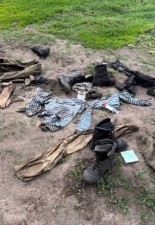
Russian clothing, boots, equipment and loot littered the battlefield in Moschun and Irpin.
The bodies of dead Russian soldiers no longer littered the battlefield, but they were left behind in their withdrawal – which provides another insight into the shallow ethical underpinnings and values of the Russian army. LINK TO VIDEO OF DAMAGE IN MOSCHUN
Russian electronic warfare (EW) was vicious and effective at the beginning of the Battle for Kyiv. The Ukrainian forces were often “blinded” by it, it took down their eyes and ears, and often fell back to old fashioned runners when their communications went down. The two commanders with whom I spoke shook their heads when remembering it[8]. They noted that Russian artillery, EW, and drones were superior in every way, to include in significant numerical superiority. Despite these disadvantages, however, it was superior leadership, morale, innovation and the will to fight for their country that favored the Ukrainians.
The Ukrainian Armed Forces leadership at the field grade officer-level – particularly Lieutenant Colonels and Colonels who command battalions and brigades – are the leaders developed under the Commander-in-Chief, General Valeriy Zaluzhnny. Their attitudes and performance are clear reflections of General Zaluzhnny’s values and style, and he has honed those attributes in his subordinates over the past eight years. Put bluntly, he is an amazing western-style leader, and his subordinates love him. They have all been at war for eight years and are battle hardened. They are by far the most battle-hardened Army in all of Europe. This was a clear advantage that the Ukrainians had over the Russian army, the Russian army consisted primarily of untested leaders and conscripts. As soon as Russia invaded, the Ukrainians executed their plan to channel the enemy into this massive kill zone north of Kyiv. The Russians attempted at least three unsuccessful river crossings and experienced a high level of attrition each time, in some cases losing entire battalions. One could even make the case for Divine Intervention as the River of Irpin was 15 feet higher than normal, which backed up the estuary. The Ukrainian Commander, Colonel Vdovychenko Oleksandr[9], took advantage of this situation by demolishing the dam holding back this water, which flooded the area and hampered the Russian airborne mechanized advance even more by swamping their vehicles and making off-road maneuver impossible. Despite this situation, the Russians continued to try and advance en masse. Moreover, the Ukrainians nullified the 20:1 Russian artillery advantage with extremely effective, precise, and lethal artillery fire on those crossings.
Russian mass artillery was often hit effectively with Ukrainian counter-battery fire. Unfortunately, a Ukrainian blogger in his Moschun home with a battery outside his window took a live feed of Ukrainian outbound counter fire during the Battle for Kyiv. The Russians, who were monitoring the live feed, reverse triangulated and determined the location of the Ukrainian battery and sent in a hypersonic missile that took out a large part of the battery with many killed in action (KIA). The Ukrainian Commander was clearly emotionally devastated remembering those losses. The soldiers just disappeared. The families are asking him for their bodies, and it clearly bothers him. They just disappeared. I asked “how many soldiers did you lose” and his answer was “every one is one too many”. A very different attitude towards the value of human life than the Russians who coldly leave their dead all over the battlefield. That blogger already is in jail for 15 years, since Ukrainian security did what the Russians did and tracked him. They have also let the population know his crime so no one else does it. The power of social media in wartime can have many direct and second and third order effects.
While the Russian army outnumbered the Ukrainian forces with two Russian divisions - 76th Guards Air Assault Division and the 98th Guards Airborne Division – and the 155th Separate Marine Brigade against a single Ukrainian brigade – the 72nd Brigade (Mechanized) – the Battle for Kyiv came down to a few key engagements. One key event was in the forest north of Moschun where a local farmer reported a heavy concentration of tanks. The Ukrainian Armed Forces sent up drones but could not identify any enemy due to the thick forest cover. They fired artillery into the forest and a massive secondary explosion confirmed their fears. A large unit from the Russian Army was there. The Russians, having been exposed, attacked immediately with tanks and armored personnel carriers, with EW that was so effective it disabled a lot of the Ukrainian drones and communications.
A Ukrainian Commander, Major Dmytro Zaretsky, was ordered first to liberate the city of Bucha (where Russian atrocities against civilians was well documented) and then to liberate the city of Irpin[10]. He had never been in the city and was not issued any maps. He was innovative, so he used Google Maps to develop a hasty plan as the Russians advanced. Furthermore, he was issued weapons systems his soldiers had never trained on such as Stinger, NLAW anti-tank, and Javelin anti-tank missiles. His soldiers used YouTube in the middle of the battle and learned to use those systems. The first Stinger launched took down a Russian helicopter. They took down six more. Javelins started taking out armored troop carriers (BTMs) and T-72 tanks about one kilometer outside of Moschun.
A second key event occurred In Irpin where the first two NLAWS destroyed the lead and trail BTM vehicles in a Russian airborne battalion column. NLAWs were in much more supply than Javelins and were very effective in urban settings with shorter ranges. After destroying the first and last armored vehicles, the Ukrainians were able to destroy 100% of the Russian airborne battalion. Many of the photos seen in the US of destroyed Russian vehicles were from that ambush. I traveled that street with the Ukrainian Colonel Noskov after the battle.
Major Zaretsky chose perfectly. Once his team destroyed the first and last vehicles, there was nowhere for the Russians in the vehicles in the middle to go. There was a clear field of fire on both sides of the Russian convoy with well-placed Ukrainian machine guns. With military communications still disabled, the Commander used WhatsApp to call in artillery strikes on the convoy. During the same battle, the Ukrainians also found a local youth in Irpin who was a computer hacker. He hacked into Russian computers to see the Russian drone footage, so the Ukrainian Commander could see everything the Russian enemy was seeing and anticipate their next moves. Major Zaretsky credits Elon Musk’s satellites as being the reason he could use the internet to use Google Maps, YouTube, WhatsApp and allow the hacker to access the Russian computers.
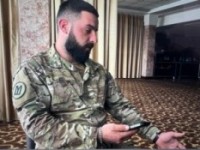

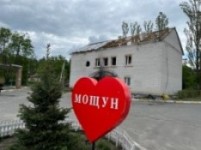
Major Zeretsky, the commander who liberated Bucha and Irpin, with destroyed Russian T-72 and a destroyed Ukrainian town hall in front a heart shaped sign that this peaceful village had as a town sign prior to the war.
A third key event centered on four soldiers who were clearing a twenty-story building in an Irpin apartment complex. Every window is now shot out. The soldiers looked down from the building and saw an entire Russian airborne company with all its vehicles parked at the base of the building. The soldiers decided to simply drop smoke grenades on the convoy. The Russians were so confused that they ran away, leaving all their vehicles, equipment, and many weapons which the Ukrainian soldiers captured and were later put to use by the Ukrainians.
At the pivotal point in the Battle for Kyiv, on 21 March 2022, the 72nd Brigade for Ukraine was taking huge losses. The Brigade Commander Colonel Vdovychenko Oleksandr, called the Commander-in-Chief, General Zaluzhnyy, and requested permission to withdraw. Zaluzhnny told him that if he withdrew, and the Russians pushed through the chokepoint, and flooded into Kyiv, they would lose Kyiv and likely the war.
General Zaluzhnny ordered Colonel Olesksandr to fight to the last soldier. Oleksandr’s unit did not withdraw and held fast. They fired many more Stingers, NLAWs and Javelins. And eventually the Russians withdrew. The world almost lost Kyiv and thus Ukraine. As that Brigade Commander in Moschun personally told me that story, he said "nature and people saved Ukraine that day.” When asked how the Stingers and Javelins performed, he raised his thumb, with a destroyed Russian armored personnel carrier behind him that was taken out by a Javelin from 1 kilometer, held up his thumb and said in English “super”.



Colonel Olesksandr, the hero who led the 72nd Brigade to hold the line at Moschun and Dan Rice in Moschun. Colonel Olesksandr giving a “thumbs up” when asked about Stingers and Javelins with two Russian destroyed vehicles behind him. The unit patch which in Ukrainian read “Ukraine or Death”.
When I asked what the words above a white skull on a black background of his unit patch said, the translator responded, “Ukraine or Death.” I could only imagine that would be an extremely difficult motto to fulfill, but it was completely appropriate for the unit that was told to hold the line and fight to the last man that day, did so, and as a result saved Kyiv.
The war in Ukraine is one of the most advanced and history with two very sophisticated, well-armed, and developed armies fighting the war of the future. And the future of Ukraine hangs in the balance. It is ushering in the wars of the future and all military leaders need to recognize the profound change in warfare that is occurring. Highly lethal and precision guided weapons, relatively low cost can take out high cost of capital and high concentrations of troops in tanks, armored personnel carriers, and even Naval flagships. Electronic warfare and social media can affect the outcome of a battle.
On May 21, 2022, General Mark Milley, the U.S. Chairman of the Joint Chiefs of Staff, gave the 2022 commencement address at West Point and said spoke about the future of warfare[11]. “Right now, a fundamental change is happening in the great character of war,” and that the US is battling “two global powers, China and Russia, each with significant military capabilities and both who fully intend to change the current rules-based order.” He went on about Ukraine “Yet again in Ukraine we are learning a lesson that aggression left unanswered only emboldens the aggressor. Let us never forget the massacre that we have just witnessed in Bucha nor the slaughter that occurred in Mariupol and the best way to honor their sacrifice is to support their fight for freedom and to stand against tyranny,” "You'll be fighting with robotic tanks and ships and airplanes," Milley said. "We've witnessed a revolution in lethality and precision munitions. What was once the exclusive province of the United States military is now available to most nation states with the money will to acquire them." “We can no longer cling to concepts and organizations and weapons of the past. We may not have divisions and corps of the past. We may not have tanks and Bradley’s, carriers, or manned fighters and bombers.”
General Milley’s predictions might already have proven prescient. The entire time in the warzone, I didn’t see a single manned aircraft from either Ukrainian or Russian side. The only manmade things flying through the sky were unmanned: artillery shells, missiles and drones. In fact, the last day in Lviv, the Russians sent in 10 sea-based missiles. All were shot down with three of them shot down by Stingers.
The Battle of Kyiv was one of the greatest upsets in military history. The technological, strategic, tactical and innovative changes that occurred on that battlefield are a bellwether for wars of the future and the need to develop innovative and agile leaders of character at all levels to be able to fight and win future battles.
The key to the battle, in my opinion, came down to superior leadership, a better battle plan, fewer but better weapons, innovation at all levels of the Ukrainian Army to learn on the fly, and better training.
The Battle of Kyiv has been won. The Battle for Ukraine can be won- as long as the West continues to provide Ukraine with the weapons, ammo and training that Ukraine needs to defeat the West’s main threat: Russia. The west formed NATO in 1949 out of fear of Russia. NATO is now 30 members and soon to be 32 members if Sweden and Finland are admitted. Russia is still the primary enemy of NATO. Ukraine is fighting Russia alone and needs the support of the 30 NATO members to weaken their combined enemy.
The Ukrainian offensive battle in the east and south to dislodge Russian troops is a very different than the defensive battle of Kyiv. A Ukrainian offensive needs different weapons, strategy and tactics than a Ukrainian defensive. And an offensive, even with the right weapons, will also be very costly for the Ukrainians. The terrain in east and the south of Ukraine is open plains. There is no place for an offensive to hide. In order to dislodge the Russians, the Ukrainians need a massive amount of long-range artillery, 155 mm M777 and M109 Howitzers and Multiple Launch Rocket Systems (MLRS) M270, as well as replacements for all anti-tank (US Javelins) and anti-aircraft weapons (US Stingers) that effectively defended Ukraine.
I started my career off as a Field Artillery officer, and specifically was MLRS M270 trained, prior to transferring branches into the Infantry, and have served in combat as an Infantry officer. Putin has multiple launch rocket systems (MLRS). We cannot expect the Ukrainian infantry to attack into Russian defenses being outgunned in artillery. And our 155 mm Howitzers cannot battle being outgunned by Russian multiple launch rocket systems (MLRS). Putin is the aggressor, and he brought MLRS with him, has massively outgunned artillery vs the Ukrainians, and it has been strategically important on the battlefield. Of course, Putin will protest the west providing MLRS and claim it is aggression and escalation. Military professionals know this is not true. If we would provide Ukraine with MLRS it would only be arming our ally with the exact weapons with which Putin and the Russian army currently has a massive advantage. The US doesn’t need to supply the rockets that can reach deep into Russia. On the contrary, standard MLRS rockets, which have much shorter range, would be used only within the borders of Ukraine and agreed upon by Ukraine to never escalate into Russian borders. Ukraine’s military motto is “The First Army of Peace”. This is an army that will not attack its neighbors, it is defensive in nature to protect the peace within its borders.
The US and NATO have done an amazing job helping to prepare and defend the brave Ukrainian military. In order to go on the offensive and evict Russia from Ukraine, we need to provide them with different weapons systems, in large numbers. It’s the moral imperative to help free the sovereign nation of Ukraine.

Dinner in Ms. Liudmyla Dolhonovaka, Dan Rice and Colonel Oleksii Noskov in Lviv, Ukraine on the exfil out of Ukraine at an underground history restaurant.
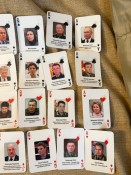
The Ukrainians used the US Iraq War concept of putting all enemy war criminals on a deck of cards. The Ace of Spades is President Vladimir Putin.
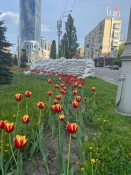

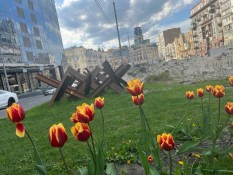
Ukrainian tank barriers and sand-bagged positions located throughout Kyiv, yet the city is showing signs of life with flowers blooming in the spring after the Battle of Kyiv.
Photos and article copyright © Dan Rice 2022
Sources:
[1] Newsweek 24 Feb 2022. https://www.newsweek.com/us-expects-kyiv-fall-days-ukraine-source-warns-encirclement-1682326
[2] Interview with General Valeriy Zaluzhnny and Dan Rice, Kyiv, Ukraine 13 May 2022.
[3] Interview with Luidmyla, Colonel Oleksii Noskov and Dan Rice, March 2022-May 2022 via Zoom and in person.
[4] Interview with General Valeriy Zaluzhnny and Dan Rice, Kyiv, Ukraine, 13 May 2022.
[5] Liudmyla Dolhonovaska and Dan Rice interview 11 May 2022, Lviv, Ukraine.
[6] Several interviews with Luidmyla Dolhonovska Colonel Oleksii Noskov and Dan Rice, May 2022, Lviv and Kyiv, Ukraine.
[7] Defense News. 5 March 2022. https://www.defenseworld.net/2022/03/05/russian-troops-destroy-javelin-nlaw-missiles-depot-using-long-range-weapon.html
[8] Interviews with General Zaluzhnny, Colonel Noskov, Ms. Dolhonovska, Colonel Oleksandr and Major Zaretsky May 2022 in Ukraine.
[9] Interview with Colonel Oleksandr and Dan Rice in Moschun translated by LT Vadym Babych, Ukraine 15 May 2022.
[10] Interview with Major Dmytro Zaretsky and Dan Rice, Kyiv, Ukraine, translated by LT Vadym Babych. 16 May 2022.
[11] General Mark Milley, 2022 West Point graduation commencement speech. https://www.youtube.com/watch?v=FGAXyrP-Lm4
Daniel Rice, MBA, MSed, MS
 ExperienceDan is the Co-President of Thayer Leadership and a 1988 graduate of the U.S. Military Academy at West Point. He is also President of the American University Kyiv, powered by Arizona State University, the first American accredited University in Ukraine. Dan is the Special Advisor to the Commander in Chief... Read More +
ExperienceDan is the Co-President of Thayer Leadership and a 1988 graduate of the U.S. Military Academy at West Point. He is also President of the American University Kyiv, powered by Arizona State University, the first American accredited University in Ukraine. Dan is the Special Advisor to the Commander in Chief... Read More +






